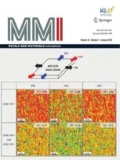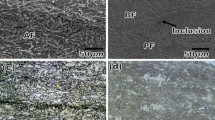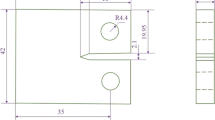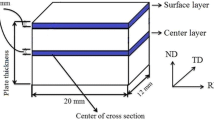Abstract
In this study, the surface and cross section of an as-received API X70 pipeline steel was studied by SEM and EDS techniques in order to categorize the shape and morphology of inclusions. Then, an electrochemical hydrogen charging using a mixed solution of 0.2 M sulfuric acid and 3 g/l ammonium thiocyanate has been utilized to create hydrogen cracks in X70 steel. After hydrogen charging experiments, the cross section of this steel has been accurately checked by SEM in order to find out hydrogen cracks. The region of hydrogen cracks was investigated by SEM and EBSD techniques to predict the role of different microstructural parameters involving hydrogen induced cracking (HIC) phenomenon. The results showed that inclusions were randomly distributed in the cross section of tested specimens. Moreover, different types of inclusions in as-received X70 steel were found. However, only inclusions which were hard, brittle and incoherent with the metal matrix, such as manganese sulfide and carbonitride precipitates, were recognized to be harmful to HIC phenomenon. Moreover, HIC cracks propagate dominantly in transgraular manner through differently oriented grains with no clear preferential trend. Moreover, a different type of HIC crack with about 15-20 degrees of deviation from the rolling direction was found and studied by EBSD technique and role of micro-texture parameters on HIC was discussed.
Similar content being viewed by others
References
R. A. Oriani and P. H. Josephic, Acta Metall. 27, 997 (1979).
C. A. Zapffe and C. E. Sims, T. Am. I. Min. Met. Eng. 145, 225 (1941).
A. S. Tetelman and W. D. Robertson, T. Am. I. Min. Met. Eng. 224, 775 (1962).
M. A. Mohtadi-Bonab, J. A. Szpunar, and S. S. Razavi-tousi, Eng. Fail. Anal. 33, 163 (2013).
M. A. Mohtadi-Bonab, J. A. Szpunar, L. Collins, and R. Stankiewich, Int. J. Hydrogen Energ. 39, 6076 (2014).
M. A. Mohtadi-Bonab, J. A. Szpunar, and S. S. Razavi-tousi, Int. J. Hydrogen Energ. 38, 13831 (2013).
X. B. Shi, W. Yan, W. Wang, L. Y. Zhao, Y. Y. Shan, and K. Yang, J. Iron Steel Res. Int. 22, 937 (2015).
Z. Y. Liu, X. Z. Wang, C. W. Du, J. K. Li, and X. G. Li, Mat. Sci. Eng. A 658, 348 (2016).
M. A. Mohtadi-Bonab, M. Eskandari, K. M. M. Rahman, R. ouellet, and J. A. Szpunar, Int. J. Hydrogen Energ. 23, 4185 (2016).
M. A. Mohtadi-Bonab, R. Karimdadashi, M. Eskandari, and J. A. Szpunar, J. Mater. Eng. Perform. 25, 1781 (2016).
T. Hara, H. Asahi, and H. Ogawa, Corros. Sci. 60, 1113 (2004).
W. K. Kim, S. U. Koh, B. Y. Yang, and K. Y. Kim, Corros. Sci. 50, 3336 (2008).
D. Hejazi, A. J. Haq, N. Yazdipour, D. P. Dunne, A. Calka, F. Barbaro, et al. Mat. Sci. Eng. A 551, 40 (2012).
Z. Y. Liu, X. G. Li, C. W. Du, L. Lu, Y. R. Zhang, and Y. F. Cheng, Corros. Sci. 51, 895 (2009).
E. M. Moore and J. J. Warga, Mater. Performance 15, 17 (1976).
V. Venegas, F. Caleyo, T. Baudin, J. H. Espina-Hernández, and J. M. Hallen, Corros. Sci. 53, 4204 (2011).
M. A. Mohtadi-Bonab, M. Eskandari, and J. A. Szpunar, Mat. Sci. Eng. A 620, 97 (2015).
M. A. Mohtadi-Bonab, J. A. Szpunar, R. Basu, and M. Eskandari, Int. J. Hydrogen Energ. 40, 1096 (2015).
H. Tamehiro, T. Takeda, S. Matsuda, K. Yamamoto, and N. Okumura, T. Iron Steel I. Jpn. 25, 982 (1985).
M. A. Al-Anezi and S. Rao, J. Fail. Anal. Preven. 11, 385 (2011).
J. Moon, C. Park, and S. J. Kim, Met. Mater. Int. 18, 613 (2012).
J. Moon, S. J. Kim, and C. Lee, Met. Mater. Int. 19, 45 (2013).
T. Y. Jin, Z. Y. Liu, and Y. F. Cheng, Int. J. Hydrogen Energ. 35, 8014 (2010).
J. Maciejewski, J. Fail. Anal. Preven. 15, 169 (2015).
R. Badji, T. Chauveau, and B. Bacroix, Mat. Sci. Eng. A 575, 94 (2013).
V. Venegas, F. Caleyo, J. M. Hallen, T. Baudin, and R. Penelle, Metall. Mater. Trans. A 38, 1022 (2007).
M. Iino, Metall. Mater. Trans. A 9, 1581 (1978).
Author information
Authors and Affiliations
Corresponding author
Rights and permissions
About this article
Cite this article
Mohtadi-Bonab, M.A., Eskandari, M., Karimdadashi, R. et al. Effect of different microstructural parameters on hydrogen induced cracking in an API X70 pipeline steel. Met. Mater. Int. 23, 726–735 (2017). https://doi.org/10.1007/s12540-017-6691-z
Received:
Accepted:
Published:
Issue Date:
DOI: https://doi.org/10.1007/s12540-017-6691-z




